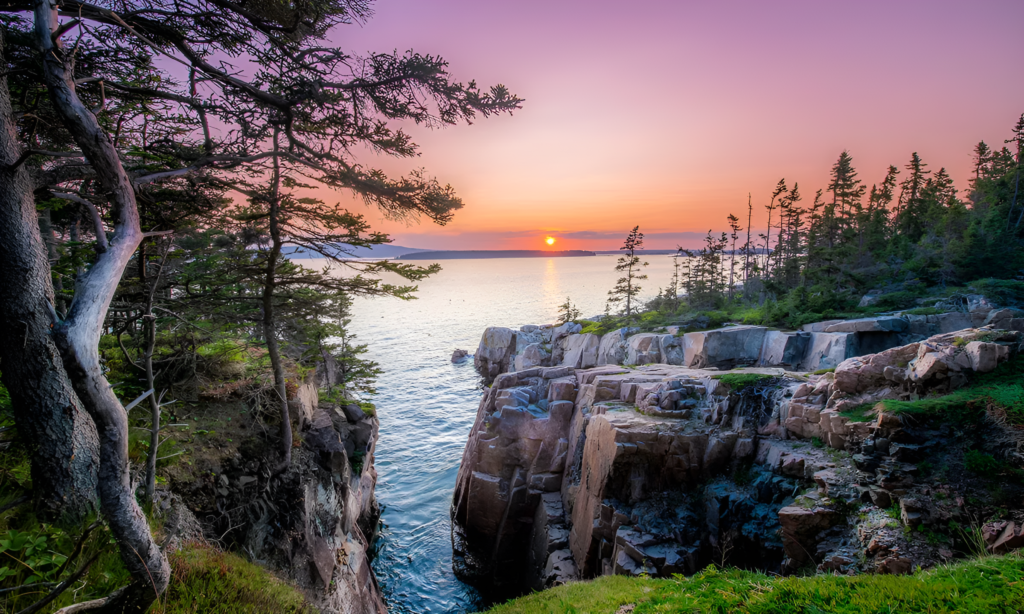Few places in the United States capture its beauty, as does Acadia National Park in Maine. It is home to stunning landscapes like rugged coastlines, dense forests, and a wide variety of things to see and do for tourists. Founded in 1916, the park protects over 47,000 acres of land on Mount Desert Island and other small nearby islands. Millions of outdoor enthusiasts are attracted to the park each year for its wide range of ecosystems and stunning landscapes.
Geography and Landscape
The territory is known for its various scene, Acadia The park merges rugged coastlines with thick forests and soaring peaks. Cadillac Mountain is one of its most well-known characteristics and marks the highest point along the U.S. coastline you can reach if headed east over water. You can hike this mountain or drive to the summit, where visitors are treated to stunning views of the sunrise over the Atlantic. The coast, too, is lovely; waves slam against granite escarpments to create views that range from flashy to Cornish.
Wildlife
Wildlife at Acadia National Park Types of Wildlife: More common sightings include white-tailed deer, red foxes, and the occasional black bear. Popular with birdwatchers as well, the area is known for its swifts and has also seen peregrine falcons, bald eagles and other migrating birds. Its varied ecosystems support and shelter a wide range of species, making it a paradise for wildlife enthusiasts.
Activities
There is no shortage of outdoor things to do in Acadia. This park offers over 120 miles of hiking trails for all levels, and its oldest official use is still one of the primary attractions today. Whether you like gentle strolls on country paths or prefer more challenging treks tackling mountain peaks, there is a walk available for all. The park also offers 45 miles of carriage roads — ideal for biking and horseback riding. The park’s many lakes and ponds make it ideal for boating, kayaking, and canoeing. Acadia becomes a snow-covered paradise in the winter months, perfect for cross-country skiing and snowshoeing.
Popular Destinations
The park has quite a few points of interest. Jordan Pond, with its raindrop-clear waters reflecting the shadow of the Bubble Mountains. There is a path along the ocean, and people can stop and have food in Jordan Pond House. The water feels cold, and next up is Sand Beach, a small but beautiful beach protected by mountains and forests. Another favorite with visitors is Thunder Hole, a natural rock inlet where the ocean crashes resoundingly.
Scenic Drives
Visitors wanting to tour by automobile can traverse the 27-mile Park Loop Road through Acadia. This drive winds through a number of the park’s most famous sights, such as Cadillac Mountain, Sand Beach, and Otter Cliff. It gives easy accessibility to trailheads, picnic websites, and overlooks. You can easily pull over to enjoy panoramic ocean views and surrounding landscapes from the roadway.
History and Culture
Acadia’s history is deeply connected to the Native American Wabanaki people, who have lived in the area for thousands of years. The land they called “Pemetic” or, “the sloping land“.By the late 19th century, Wall Street tycoons and prominent figures transformed the Island into a fashionable summer retreat by building mansions. The land was saved through the efforts of conservationists such as George B. Dorr, also known as the “Father of Acadia.” To preserve scenic values and extend public access for the benefit of future generations, they created the park.
Environmental Sustainability and Conservation
Acadia National Park plays a vital role in conservation. The park staff actively works to protect its unique ecosystems and wildlife. They improve the park’s drinking water supply, work on reforestation projects, and gather data on the long-term effects of climate change in the park. Additionally, they focus on gathering valuable insights for future conservation efforts. To preserve the park’s natural environment, guests should actively practice Leave No Trace principles.
Camping and Accommodation
Acadia offers several camping options for those looking to immerse themselves in nature. Some of the other must-see spots include Blackwoods Campground and Seawall Campground. Both provide tent and RV camping with simple facilities. For a more luxurious overnight stay, visitors can opt for hotels, inns, or bed-and-breakfasts in nearby towns like Bar Harbor and Southwest Harbor.
Best Time to Visit
The park looks great all year long, but the best time to visit is in late spring through early fall. The weather is excellent, and most of the facilities, roads, etc., will be open these months. The fall is adorable when autumn leaves turn the park into a colorful carpet of red, orange, and yellow. Winter is more solid but allows for snow activities.

